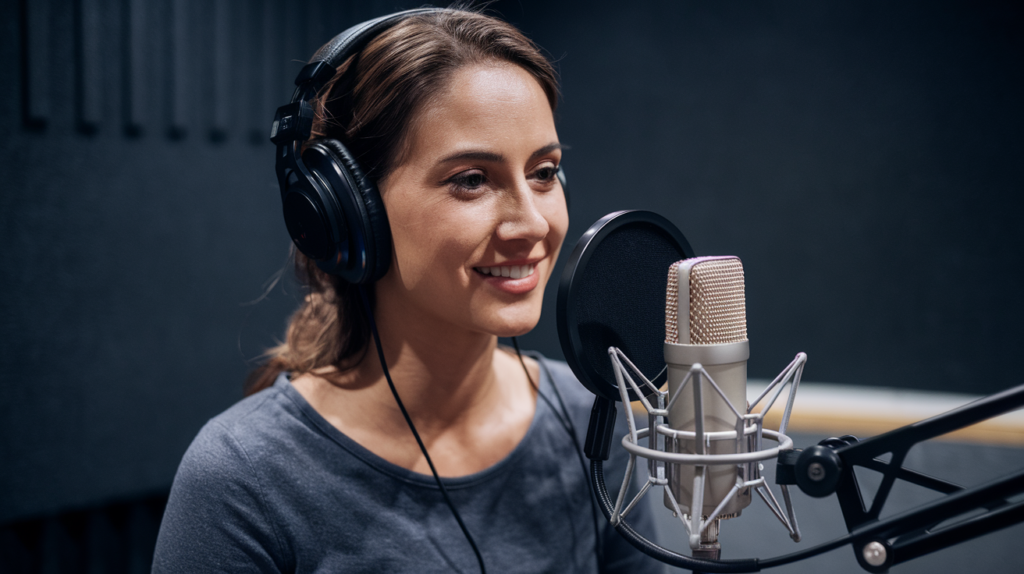Key Takeaways
- Media Influences Perception: The portrayal of the Romanian language in media significantly shapes public understanding, with both positive and negative representations impacting attitudes toward its speakers.
- Stereotypes vs. Authenticity: Early media often perpetuated stereotypes about the Romanian language through exaggerated accents and quirky dialogues; modern narratives are increasingly embracing authenticity to provide a more realistic view.
- Role of Voiceovers: Skilled voice actors enhance the representation of the Romanian language by adding emotional depth and authenticity, helping to dismantle stereotypes through relatable storytelling.
- Cultural Representation Matters: Positive portrayals of Romania’s culture in film and TV can foster pride among native speakers while promoting broader appreciation for the richness of the language.
- Challenges Persist: Despite progress, misconceptions remain prevalent due to oversimplified depictions that ignore Romania’s linguistic diversity; addressing these requires thoughtful casting and nuanced storytelling.
- Digital Media’s Impact: Social platforms offer new opportunities for promoting authentic narratives around the Romanian language, enabling communities to share their culture and engage audiences globally.
Have you ever wondered how the media shapes our perception of languages? The media portrayal of the Romanian language plays a crucial role in influencing public opinion and understanding. From movies to news reports, the way Romanian is represented can either uplift its status or contribute to stereotypes.
Overview Of The Media Portrayal Of Romanian Language
Media portrayal plays a crucial role in shaping perceptions of the Romanian language. Various platforms, from films to news broadcasts, influence how audiences view it. Movies often depict Romanian characters with thick accents or quirky dialogues, which can lead to stereotypes. Such portrayals might not reflect the reality of fluent speakers and their diverse dialects.
News reports also impact public opinion. Positive coverage showcasing Romania’s culture and history enhances the language’s prestige. Conversely, negative news stories can reinforce misconceptions about its speakers. The context in which the language appears matters significantly.
Voiceovers add another layer to this portrayal. When utilized effectively, voiceover talent can convey authenticity and emotion in projects featuring the Romanian language. A skilled voice artist captures nuances that resonate with audiences, helping dismantle stereotypes through relatable storytelling.
Overall, media representation influences perception significantly. You may notice that how Romanian is presented shapes attitudes toward its speakers and their cultural identity. Engaging narratives delivered by talented voice actors could shift perspectives positively if embraced widely across different media genres.
Historical Context
The portrayal of the Romanian language in media reflects a rich tapestry of history and cultural evolution. Understanding this context reveals how past narratives shape current perceptions.
Early Representations
Early representations of the Romanian language often emphasized stereotypes that misrepresented its speakers. In films and television, characters might have spoken with exaggerated accents or used quirky phrases, which didn’t accurately depict fluent speakers. These portrayals limited audience understanding and reinforced negative stereotypes about Romania’s culture. Such depictions can create distance between viewers and the true essence of the language, hindering appreciation for its beauty and complexity.
Evolving Narratives
Over time, narratives surrounding the Romanian language have evolved significantly. Modern media increasingly showcases diverse stories that highlight authentic voices. As filmmakers and content creators embrace more nuanced storytelling, they contribute to dismantling old stereotypes while elevating the status of the language. The inclusion of skilled voice actors further enhances these narratives, allowing for deeper emotional connections with audiences. Authentic voiceovers can breathe life into characters and stories, transforming public perception by presenting relatable experiences that resonate across cultures.
With these evolving narratives, media has become a powerful tool for influencing attitudes toward the Romanian language and its speakers.
Current Media Trends
Media trends significantly shape public views on the Romanian language. Various platforms, including television and digital media, play essential roles in conveying narratives that impact perceptions.
Television and Film
Television and film serve as powerful mediums for showcasing the Romanian language. Recent productions increasingly feature authentic representation, breaking away from outdated stereotypes. Viewers now encounter complex characters who speak fluently without exaggerated accents or quirky dialogues. These portrayals create relatable experiences that resonate with audiences.
Incorporating skilled voice actors enhances these stories further. A talented voice over artist brings depth to characters, allowing viewers to connect emotionally with the narrative. This evolution in storytelling encourages a broader appreciation of the Romanian language’s beauty and richness.
Digital Media and Social Platforms
Digital media platforms have transformed how content is consumed, offering diverse opportunities for promoting the Romanian language. Social media channels showcase vibrant communities where speakers share their culture through engaging videos and posts. These interactions foster a sense of belonging while elevating the status of the language.
Voiceovers in online content also play a crucial role in this shift. Creators harness voice over talent to convey emotions effectively, making messages more impactful. When you hear a compelling story narrated by an expert voice actor, it captures attention and nurtures understanding.
Engaging narratives that utilize well-cast voices can dismantle misconceptions about the Romanian language while fostering appreciation among global audiences. As digital media continues to evolve, so does its potential to reshape how people perceive not only languages but cultures as well.
Impact On Public Perception
Media portrayal significantly influences how the public perceives the Romanian language. Through various forms of media, stereotypes can either be reinforced or dismantled, shaping attitudes towards both the language and its speakers.
Language Identity
Language identity plays a crucial role in how individuals relate to their cultural heritage. When the Romanian language is portrayed authentically in films and television, it fosters a sense of pride among native speakers. Unfortunately, when characters are depicted with thick accents or exaggerated mannerisms, it can create misunderstandings about what it truly means to speak Romanian fluently. Authentic depictions that showcase diverse dialects highlight the richness of Romania’s linguistic landscape and empower speakers to embrace their identity without fear of judgment.
Cultural Representation
Cultural representation within media further impacts public perception. Positive portrayals can illuminate Romania’s vibrant culture, showcasing traditions, art, and everyday life through engaging narratives. For instance, skilled voice actors enrich these stories by adding authenticity and emotional depth through their performances. This approach not only captures viewers’ attention but also helps break down stereotypes associated with the Romanian language. When audiences encounter relatable characters who communicate in authentic ways—without relying on clichés—they gain a deeper appreciation for Romania’s culture and history.
Effective media representations enhance public understanding of the Romanian language while fostering respect for its speakers and cultural significance. By embracing nuanced storytelling that highlights real experiences through talented voice artists, media can transform perceptions positively.
Challenges And Misconceptions
Media portrayals of the Romanian language often face significant challenges, leading to widespread misconceptions that affect public perception. These stereotypes can skew how audiences view not only the language but also its speakers.
Stereotypes In Media
Stereotypes in media frequently depict Romanian characters with exaggerated accents or quirky dialogues, which don’t reflect the reality of fluent speakers. Such portrayals can create a distorted image, making it easy for audiences to pigeonhole an entire culture based on limited representations. As a result, many viewers might assume that all Romanian speakers share these traits, overlooking the rich diversity within the language itself.
Voiceovers play a crucial role in shaping these narratives. Skilled voice actors can lend authenticity and depth to characters, helping to break down existing stereotypes. When creators prioritize accurate representation through quality voice talent, it fosters a more nuanced understanding of Romania’s cultural landscape.
Language And Dialect Diversity
Language and dialect diversity adds another layer of complexity to media portrayals. The Romanian language boasts various regional dialects that reflect its historical and geographical richness. However, mainstream media often overlooks this diversity, opting instead for simplified versions that reinforce existing misconceptions.
Through careful casting choices—such as employing voice artists from different regions—producers can showcase authentic dialects in their projects. This approach not only enriches storytelling but also educates audiences about the complexities of the Romanian language. By embracing diverse voices in media content, producers contribute positively to public understanding and appreciation of Romania’s linguistic heritage.
Addressing challenges and misconceptions surrounding the Romanian language requires thoughtful representation in media. Engaging narratives backed by skilled voiceovers have the power to reshape perceptions and promote a deeper connection with this vibrant culture.
Conclusion
Media representation shapes how you perceive the Romanian language and its speakers. Authentic portrayals in films and digital platforms can foster appreciation for the language’s beauty while dismantling harmful stereotypes. As these narratives evolve to reflect genuine cultural experiences, they encourage a richer understanding of Romania’s diverse linguistic heritage.
By highlighting skilled voice performances and relatable characters, modern media cultivates pride among native speakers and invites global audiences to connect with their stories. Your engagement with these narratives not only enhances your appreciation but also contributes to a more nuanced view of the Romanian language and culture. Embracing this shift in representation can lead to a deeper respect for Romania’s vibrant traditions, enriching your perspective on its linguistic significance.
Frequently Asked Questions
How does media impact public perception of the Romanian language?
Media plays a critical role in shaping how people view the Romanian language. Positive portrayals can enhance its status, while negative representations often reinforce stereotypes. This influence extends across various forms of media, including films and news reports.
What stereotypes are associated with the Romanian language in media?
Common stereotypes include exaggerated accents and quirky dialogues that do not reflect the reality of fluent speakers. These misrepresentations can lead to misunderstandings about the language’s complexity and beauty.
How have historical portrayals affected current perceptions of Romanian?
Early media representations emphasized negative stereotypes, impacting audience understanding. However, modern narratives increasingly showcase diverse stories and authentic voices, helping reshape perceptions over time.
Why is cultural representation important in media portrayals?
Cultural representation enriches narratives by showcasing Romania’s vibrant culture and traditions. Positive portrayals foster pride among native speakers and contribute to a better understanding of their linguistic heritage.
What role do voice actors play in changing perceptions?
Skilled voice actors enhance storytelling by adding authenticity and emotional depth. Their work helps dismantle old stereotypes while presenting relatable experiences that resonate with global audiences.
How do digital platforms influence views on the Romanian language?
Digital media showcases vibrant communities where speakers share their culture, fostering belonging and elevating the language’s status. Engaging narratives on these platforms help challenge misconceptions about Romanian speakers.
What challenges do Romanian-language portrayals face in media?
Media often perpetuates widespread stereotypes that skew audience perceptions, leading to a distorted image of Romanian speakers. These challenges highlight the need for more nuanced storytelling that reflects linguistic diversity.
How can producers improve representations of the Romanian language?
By employing voice artists from various regions, producers can showcase authentic dialects and enrich storytelling. This approach educates audiences about Romania’s linguistic heritage while promoting appreciation for its richness.







